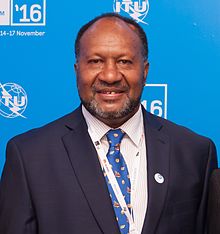History of Vanuatu
The History of Vanuatu deals with the history of the Pacific state of Vanuatu , which has been independent since 1980.
Early history
Little is known about the history before the arrival of the Europeans. Many of Vanuatu's islands have been inhabited for thousands of years. It is believed that the first humans came to Vanuatu from Papua New Guinea around 3500 years ago . In the millennia that followed, different tribes formed that were at war with one another. Oral tradition shows that Chief Roy Mata managed to unite the tribes and thus became the first significant figure in Vanuatu's history.
Arrival of the Europeans
The first European to set foot on Vanuatu soil was the Portuguese Pedro Fernández de Quirós in 1606. He was in Spanish service and set out to find the southern continent. When De Quiros reached Big Bay in Vanuatu, he believed he had reached his destination and named the islands Australis de Espiritu Santo . De Quiros declared the islands the property of the Spanish crown, but was unable to convince the Spanish court of his discoveries on his return. So Vanuatu fell into oblivion for a long time. It was not until 1768 that another European, the Frenchman Louis Antoine de Bougainville, sailed to Vanuatu and refuted De Quiros' theory that Vanuatu was part of the southern continent.
In 1774 James Cook reached Vanuatu territory on his second voyage and named it "New Hebrides". Intensive explorations were denied to him due to hostile natives. Even so, Cook made the discovery that there were two different types of natives on the islands. On the one hand, dark, short people and, on the other hand, taller, light-skinned people. It was found that the former were Melanesians and the latter were Polynesians .
colonization
In the decades that followed, there was an increasing number of French and British settlements. The Irish trader Peter Dillon discovered a large stock of sandalwood on Vanuatu in 1825 . Then the Europeans began to cut sandalwood, as China had a great interest in this raw material and it was hoped that it would be a good trade. As a result, the number of indigenous people was decimated as they were charging excessive prices for deforestation.
From 1887 Vanuatu was officially under British-French control. In 1906 both countries founded the New Hebrides condominium . Vanuatu was ruled by the British and the French from now on. When the condominium was founded, the indigenous people were officially without nationality. They were not allowed to call themselves Vanuatu citizens. Their population decreased to 45,000 by 1935.
During the Second World War , Great Britain and France used the two islands of Efate and Espiritu Santo as military bases. In the war years from 1942 to 1945, the USA briefly took control of Vanuatu and successfully built an infrastructure. After the end of the war, they left the island again. Through contact with African-American soldiers, anti-colonial ideas became known and increasingly popular on the island.
independence

From the 1960s the population began to strive for independence, which was supported by the independence movement "Vanua 'aku Pati" from 1971. At first, the French braced themselves against this project, as they feared a wave of decolonization and wanted to keep the resource-rich New Caledonia . Before independence, active and passive women's suffrage was guaranteed in November 1975.
In 1977 Great Britain and France were ready to give in to the demand for independence. The island state achieved full sovereignty on July 30, 1980 with the approval of the two European protecting powers. The country is still a member of the Commonwealth of Nations . The right to vote for women was confirmed when independence was achieved .
The Anglican clergyman Walter Lini became the first Prime Minister . Since the population had split into Anglophiles and Francophiles in the previous decades, many Francophiles left the islands after the Prime Minister was appointed.
In 1981 Vanuatu joined the United Nations ; two years later the Non-Aligned Movement . In 1988 contracts for closer cooperation with the Solomon Islands were signed. In the same year, Prime Minister Lini and Head of State Sokomanu were deposed. The 1990s were marked by political instability, which manifested itself in frequent changes of government and a decentralization of the islands. Charlot Salwai has been Prime Minister of Vanuatus since 2016 .
Web links
Individual evidence
- ↑ a b - New Parline: the IPU's Open Data Platform (beta). In: data.ipu.org. July 30, 1980, accessed October 13, 2018 .
- ^ Dieter Nohlen, Florian Grotz, Christof Hartmann (eds.): South East Asia, East Asia and the South Pacific. (= Elections in Asia and the Pacific. A Data Handbook. Volume 2). Oxford University Press, New York 2002, ISBN 0-19-924959-8 , p. 836
- ^ Mart Martin: The Almanac of Women and Minorities in World Politics. Westview Press Boulder, Colorado, 2000, p. 414.

